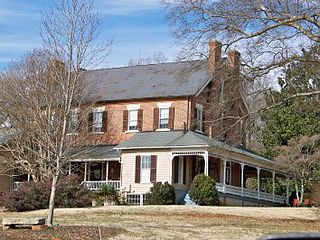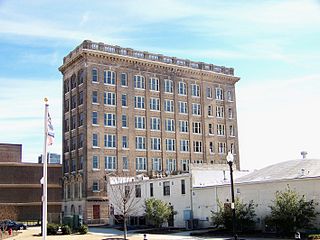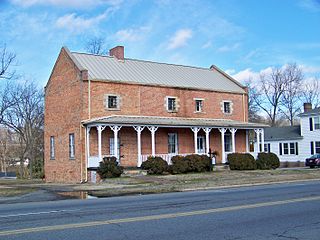
Gaston County is a county in the U.S. state of North Carolina. As of the 2020 census, the population was 227,943. The county seat is Gastonia. Dallas served as the original county seat from 1846 until 1911.

Belmont is a small suburban city in Gaston County, North Carolina, United States, located about 9 miles (14 km) east of Gastonia. The population was 10,076 at the 2010 census. Once known as Garibaldi Station, it was named for the New York banker August Belmont. Belmont is home to Belmont Abbey College.

Dallas is a town in Gaston County, North Carolina, United States, and a suburb of Charlotte, located north of Gastonia. The population was 4,488 at the 2010 census. It was named for George M. Dallas, Vice President of the United States under James K. Polk.

Gastonia is the most populous city in and the county seat of Gaston County, North Carolina, United States. It is the second-largest satellite city of the Charlotte area, behind Concord. The population was 80,411 in the 2020 census, up from 71,741 in 2010. Gastonia is the 13th-most populous city in North Carolina. It is part of the Charlotte-Concord-Gastonia, NC-SC Metropolitan Statistical Area, which is part of the Charlotte-Concord, NC-SC Combined Statistical Area.

Mount Holly is a small suburban city in northeastern Gaston County, North Carolina, United States. The city is situated just west of the Catawba River, north of Interstate 85, south of North Carolina State Highway 16. The population was 17,703 at the 2020 census, up from 13,656 in 2010.

Frank Pierce Milburn was a prolific American architect of the late 19th and early 20th centuries. His practice was primarily focused on public buildings, particularly courthouses and legislative buildings, although he also designed railroad stations, commercial buildings, schools and residences. Milburn was a native of Bowling Green, Kentucky who practiced as an architect in Louisville from 1884 to 1889; Kenova, West Virginia 1890–1895; Charlotte, North Carolina; Columbia, South Carolina; and Washington, D.C. after 1904. From 1902 Milburn was architect for the Southern Railway.
David Aaron Jenkins was a Republican politician and North Carolina State Treasurer from 1868 until 1876. His home was listed on the National Register of Historic Places before being demolished.

The Cleveland County Courthouse is a courthouse building located at Shelby, Cleveland County, North Carolina.

Gastonia High School is a historic high school building located at Gastonia, Gaston County, North Carolina. It was designed by Hugh Edward White and built in 1922–1924. It is a five-story, heavily ornamented E-shaped Tudor Revival-style red brick school. It has a flat roof with parapet and features a four-bay projecting frontispiece and two-story, elegantly finished, auditorium. It has a six bays long and three bays wide addition built in 1955.

William J. Wilson House is a historic home located near Gastonia, Gaston County, North Carolina. It was built about 1824, and is a two-story, five-bay, Federal-style brick dwelling. Its brickwork is laid in Flemish bond. It has a side-gable roof and exterior brick end chimneys. It features a one-story, Late Victorian porch with porte cochere.

Third National Bank Building is a historic office building located at Gastonia, Gaston County, North Carolina, USA. It was designed by Milburn, Heister & Company and built in 1923. It is an eight-story, four bay wide, English Tudor Revival-style steel frame building. It is sheathed in dark red brick and stone with a molded terra cotta covered top story. It features a projecting main entrance with a two-story segmental arched opening.

First National Bank Building, also known as the Lawyers Building, is a historic office building located at Gastonia, Gaston County, North Carolina. It was designed by Wilson & Sompayrac and built in 1916–1917. It is a seven-story, rectangular, Classical Revival-style steel frame building. It is sheathed in cream-colored brick with limestone and terra cotta trim.

Robinson–Gardner Building, also known as the Robinson Brothers Building, is a historic commercial building located at Gastonia, Gaston County, North Carolina. It was built in 1899, and is a two-story, three-bay, brick building with Renaissance Revival-style design elements. The second story of the front facade features a round arch with a decorative cartouche at the keystone position and terra cotta swirls at the bases. Within the arch is a pressed metal swag between a pair of ribboned wreaths pierced by vertical torches. Above the arch, pressed metal wreaths hold another, larger, metal swag.

Dallas Historic District is a national historic district located at Dallas, Gaston County, North Carolina. It encompasses eight contributing buildings surrounding the courthouse square and dated between about 1840 and 1900. Dallas served as the county seat of Gaston County from 1847 to 1911. They are the Greek Revival style old Gaston County Courthouse, which now functions as the Dallas Town Hall; the county jail; the Hoffman Hotel; the Rhyne Store; the Smyre-Pasour House; the Matthews Hotel; the Late Victorian style Wilson-Spargo House; and the Setzer General Store.

Downtown Gastonia Historic District is a national historic district located at Gastonia, Gaston County, North Carolina. It encompasses 77 contributing buildings and 1 contributing object in the central business district of Gastonia. The commercial, civic, institutional, and multi-unit residential buildings were built between the 1890s and 1954, and include notable examples of Colonial Revival and Classical Revival architecture. Located in the district are the separately listed former Gaston County Courthouse, First National Bank Building, Third National Bank Building, and Robinson-Gardner Building. Other notable buildings include the U.S. Post Office (1935), York Medical Building (1938), Kress Department Store, Leibowitz Department Store, Ideal Moving Picture Theater, City Hall, Kirby Building (1922), First Baptist Church (1922), Gaston County War Memorial Hall (1928), and the (former) Gaston County Public Library (1930).

York-Chester Historic District is a national historic district located at Gastonia, Gaston County, North Carolina, United States. It encompasses 649 contributing buildings, 2 contributing sites, and 1 contributing structure in a predominantly residential section of Gastonia. The dwellings were built between about 1856 and 1955, and include notable examples of Queen Anne and Bungalow / American Craftsman architecture. Located in the district are the separately listed former Gastonia High School. Other notable contributing resources include the Beal-Ragan Garden, Oakwood Cemetery, Caroline Hanna House, Spurrier Apartment building, Edgewood Apartments, the Joseph W. Lineberger House and Devant J. and June S. Purvis House (1951).

Loray Mill Historic District is a national historic district located at Gastonia, Gaston County, North Carolina. It encompasses 649 contributing buildings, 2 contributing sites, and 1 contributing structure in a predominantly residential section of Gastonia. The district includes the five-story brick Loray Mill and all or parts of some thirty blocks of frame mill houses constructed primarily between the early 1900s and the 1920s. They include notable examples of Colonial Revival, Gothic Revival, and Bungalow / American Craftsman architecture. Other notable buildings include the Loray Baptist Church (1952).

City Hospital-Gaston Memorial Hospital is a historic hospital complex located at Gastonia, Gaston County, North Carolina. The complex consists of: the 1924 Classical Revival-style City Hospital designed by architect Charles Coker Wilson; the 1951 Gaston Memorial Hospital; the 1957 addition that connects them; and a 1947 nurses’ school and dormitory. The original section is a four-story, 12 bay by 3 bay, brick building.

Bradley Station is a bus station located in Gastonia, North Carolina, United States. It serves as a bus terminus for Gastonia Transit (GT) and provides intercity bus service via Charlotte Area Transit System (CATS), Greyhound Lines, and Sunway Charters.




















